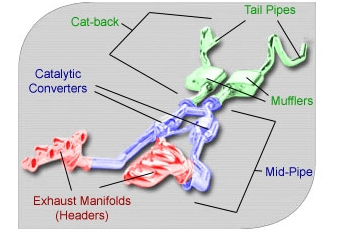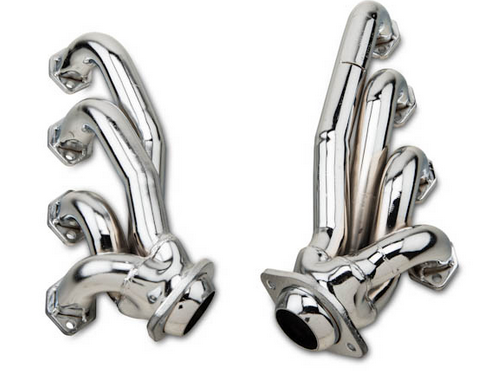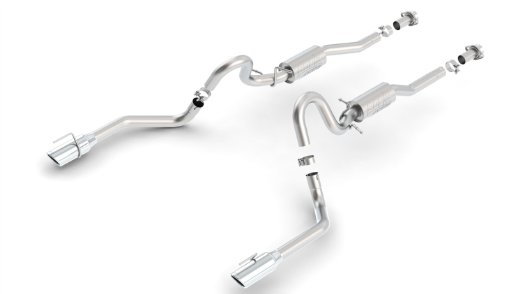Ford Mustang GT 1996-2004: Exhaust Modifications
Exhaust modifications can enhance the sight, sound and performance of your Mustang GT. Learn about the various options available by starting with the basics.
This article applies to the Ford Mustang GT (1996-2004).
More performance. More horsepower.
It's what every Mustang GT owner craves, but you want to do it without breaking the bank. Your engine loves to breathe freely, and the easier it is for air to come in and go out, the more horses you can summon. We all know about the boost that comes from air intake modifications, but let's not overlook the exhaust. Not only can you add some horsepower with an upgrade, but you also get the sound bonus at no extra cost. There's no shortage of options here: headers, mid-pipes, cat-back exhausts and rear mufflers can all maximize the air flow through your engine while minimizing the cash flow out of your wallet.
The Mustang Exhaust System
Any car owner knows what and where a muffler is, but what about an X or H-pipe? It can certainly be confusing, but it's all about understanding the basics first. The exhaust is the by-product of combustion in the engine, and it starts its exit flow at the exhaust manifold, also known as the factory headers (Figure 1). From there, it flows down through the mid-pipe that contains the catalytic converter on stock configurations. The combination of the muffler and tail pipes is what's known as the cat-back exhaust, because it bolts behind the "cat." That's it in a nutshell, now let's take a closer look at each one in more detail.

Headers

DIY Cost – $300-$1,000
Professional Cost – $500-$1,500
Skill Level – Moderate to Hard; getting to the headers can be challenging, and replacing them will require a helper.
Your engine comes with a stock exhaust manifold, and it serves the basic purpose of channeling the exhaust gases from the cylinders out to the mid-pipe.
Aftermarket headers come in two flavors: shorty and full length headers. Shorty headers are about the same size as your stock manifold, and therefore work fine with the stock as well as standard size aftermarket mid-pipes. These will provide a good bump in horsepower and torque for a fairly straightforward swap for the stock manifold.
The long tube and full length headers cost more and provide more horsepower/torque than the shorty headers. The downside is that they will not match up with the stock mid-pipe, and therefore will need to be paired up with a shorty mid-pipe. If you decided to go this route, be sure to buy both the long tube header and the shorty mid-pipe to save you the frustration of pairing up two incompatible models.
X/Y/H Mid-Pipes

DIY Cost – $250-$650
Professional Cost – $500-$900
Skill Level – Moderate; fairly straightforward replacement, but a lift and some assistance is highly suggested.
Exhaust leaving the manifold heads into the mid-pipe. GT models come with an H formation known as an H-Pipe, while V6 Mustangs come with a Y-pipe. There are aftermarket models like the X-Pipe.
The stock mid-pipes come "catted" (with the catalytic converter), but there are plenty of aftermarket options without a cat. Keep in mind that these are intended for racing and off-road applications, as many would not pass state emission inspections.
Standard length mid-pipes are made to work with stock manifolds and shorty headers, but long tube headers require the equivalent "shorty" mid-pipe to work properly.
Cat-Back Exhausts

DIY Cost – $400-$900
Professional Cost – $600-$1,300
Skill Level – Moderate; a lift is recommended and some assistance mounting the complete assembly would be needed.
The cat-back exhaust is just that—the exhaust that bolts behind the catalytic converters.
It generally includes everything you need to get the gases from the mid-pipe through the muffler and out the tail pipe. It includes a section of pipe from the muffler to the mid-pipe, as well as the larger diameter tips that exit the muffler and protrude from the back of the bumper.
The cat-back exhaust comes in all shapes and sizes, and includes a wide variety of muffler types to provide maximum airflow and a sound to suit every preference.
Related Discussions
- X-pipe vs. MAC Prochamber - MustangForums.com
- Top Ten Performance Bolt-ons - MustangForums.com
- Best Bang for the Buck Exhaust - MustangForums.com
- Exhaust Sound Clips - MustangForums.com
- Best Exhaust Combo - MustangForums.com






